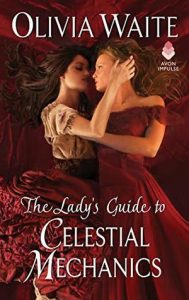Minor spoilers toward the end
Olivia Waite’s The Lady’s Guide to Celestial Mechanics is a fun historical romance about a widowed countess and lady astronomer. Lucy wants to pick up her father’s work and do the translation for a famous French astronomer for England’s science society, but lo and behold, they’re all men and sexist as hell. Lady Catherine, the society’s main patroness, doesn’t care for that at all and takes her funds to Lucy’s endeavors. Naturally, they fall in love, and romance and angst ensue.
The driving force behind Lucy and Catherine’s meeting is heartbreak. Lucy, who’s always known she only loves women, wants to run away from home after so much loss. Aside from being rejected by her lover who chooses to marry a man, her father passes away. She loved him dearly and worked alongside him for so many years. When she comes across the work of Oléron, the famous French astronomer, among her father’s work, she’s determined to throw herself into this work as well.
Lady Catherine, recently a widow, only wants to take a lover to satisfy her needs. She doesn’t want love and romance, and she certainly doesn’t want to get married again. But her previous lover after her late husband’s death wanted to marry her, so she had to call off the affair. In comes Lucy, stirring feelings in her she never knew she could have for a woman, and the idea strikes her: if she takes on a woman as a lover, she’d never have to marry. As is bound to happen in a romance novel, when two characters are running away and most definitely NOT looking for love, they find each other.
The sweetest part of their romance is how much they support one another. While Lady Catherine finances Lucy’s translation work and assures her she’s just as brilliant as the cocky bastards in the society, Lucy validates Catherine’s own artistic talents and assures the Lady her needlepoint skills have as much merit in the art world as any painter or sculptor. Together, they help each other realize their dreams. This balance and celebration of both STEM and the arts makes Lady’s Guide a delightful narrative that highlights how these pursuits complement one another.
Waite creates a highly sensual atmosphere with the sex scenes between Lucy and Catherine. They highlight the importance and eroticism of consent, as well as taking charge of one’s pleasure and desires. There’s never any shame between the two women, even as Catherine engages in intimacy with a woman for the first time. She’s never repulsed by her feelings, but rather confused, as she never thought it possible. Lucy in turn shows a great deal of respect for her partner, making sure she’s comfortable and enthusiastic every step of the way. They both take great care to address each other’s needs.
Minor spoilers:
Perhaps one of the best moments in the book is when it’s revealed that Oléron is a woman. The whole time the society, and Lucy herself, assumed the famous French astronomer was a man. This point gets tangled in Lucy’s discovery of other women like herself who have studied and furthered the sciences through history and who were silenced or else had their work taken by their fathers, brothers and other men. It leads her to her newest endeavor, which is to collect the work of these women and continue their scientific pursuits while giving them their due credit. A wonderful feminist ending for a Regency story with misogynistic conflict.


